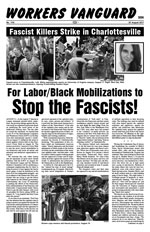
On Labor Strikes During WWI (Letter) 29 July 2017 Dear comrades, I was happy to find the quote of the week for the current Workers Vanguard (No. 1115, 28 July) dedicated to Wobbly hero, Frank Little, who was murdered by thugs on the order of the Anaconda Copper Mining Company in Butte, Montana, in August 1917. One of the reasons that the piece by then-Communist Party leader James P. Cannon was so powerful is that Cannon wrote from personal experience: he had worked with Little during the 1913 Duluth, Minnesota, ore-dock workers strike. The introduction to the quote refers to the Butte copper strike as “the only mass strike in a basic industry in the U.S. during the first interimperialist world war.” But this is not true. Less than three months after the United States Congress declared war on Germany in April 1917, the Industrial Workers of the World (IWW) led a strike of copper miners in Southern Arizona. The IWW demanded better and safer working conditions; the end of discrimination against union members; a flat wage scale (instead of a wage tied to the price of copper); and equal treatment for foreign and minority workers. Little played a leading role in the strike—and was demonized by the press and the government for daring to strike during the war. Little reportedly told the Arizona governor, “I don’t give a damn what country your country is fighting, I am fighting for the solidarity of labor.” On 12 July in Bisbee, some 2,000 thugs, under the command of the sheriff, rounded up more than 1,000 men—including Little. At gunpoint, they were loaded in manure-filled boxcars and deported to the New Mexico desert and left for dead. Little found his way to Butte—to continue to fight for the solidarity of labor. Comradely,
|
|
||||||||||||||||||||||||||||||||||||||||||||||||
